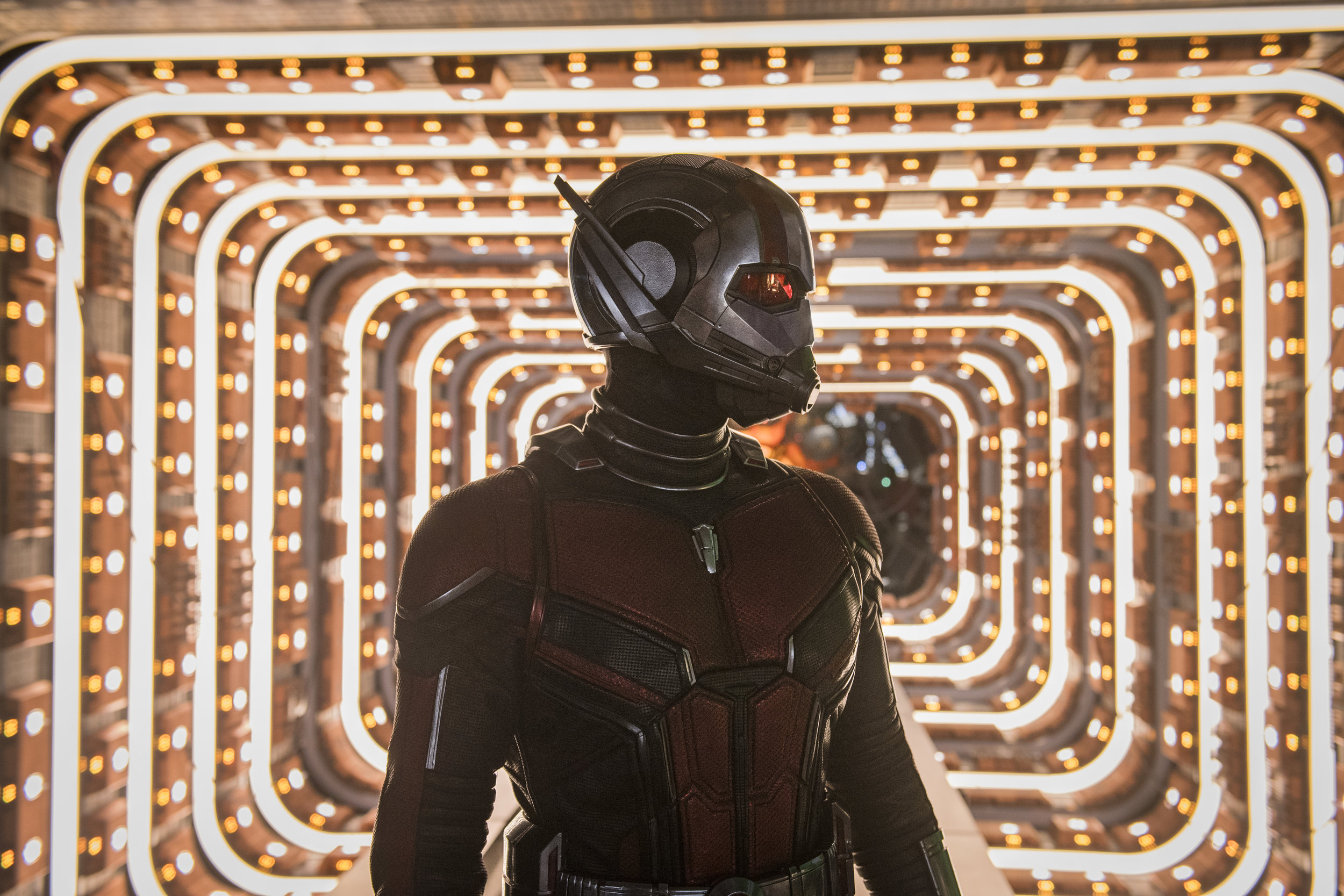'Ant-Man and the Wasp': Some necessary shrinkage for the Marvel Cinematic Universe
Paul Rudd is Ant-Man in "Ant-Man and the Wasp." (Photo courtesy Disney/Marvel)
A running joke in “Ant-Man and the Wasp” involves the script’s repetition of the word “quantum.” “Do you guys just put the word ‘quantum’ in front of everything?” Paul Rudd’s character, Scott Lang, a.k.a. the astonishing, shrinking, and sometimes enlarging Ant-Man, asks his fellow characters. Funny, I happened to be wondering the same thing.
The movie is best described as quantum silliness, and therefore a tonal counterpoint to the previous Marvel Cinematic Universe entry, the grim, entertaining “Avengers: Infinity War.” Ant-Man was among the few franchise heroes not to make an appearance in “Infinity War,” which, in the proper comic-book parlance, was a crossover of fiery, cataclysmic proportions. “Ant-Man and the Wasp” explains why he wasn’t there, and how he fits into the larger story, and it’s something that must be mentioned, lest the cinema’s most ambitious and all-consuming franchise go unrecognized in the cultural conversation for three minutes, something that just can’t happen.
This isn’t the focus of “Ant-Man and the Wasp,” though. It’s a mostly self-contained trifle, like the first “Ant-Man” film, released in 2015 - several infinities ago, it seems. Anyway, Lang missed the war of the infinite because he has an electronic tether on his ankle. He’s under house arrest because he left the country to fight in 2016’s “Captain America: Civil War,” violating his parole. You’ll no doubt recall that film for how he showcased a previously unseen ability to become not only very tiny, but also very large (Giant-Man, informally).
Evangeline Lilly is the Wasp in "Ant-Man and the Wasp." (Photo courtesy Disney/Marvel)
But I’m getting bogged down here. It’s easy to do, when the context is so dense, and unavoidable. Directed, like “Ant-Man,” with extreme competence by Peyton Reed, “Ant-Man and the Wasp” tells the story of an inner infinity. Thirty years ago, Michael Douglas’ Hank Pym was the first Ant-Man, and his wife, Michelle Pfeiffer’s Janet Van Dyne, was the original Wasp, who does all the same stuff as Ant-Man, but with built-in wings. What with one thing and another, Janet was trapped in a subatomic realm, presumed dead. See, the first rule of Marvel Cinematic Universe extreme shrinkage is, don’t go subatomic. Your brain gets melty, and you might never emerge from the psychedelic climax of “2001: A Space Odyssey” which, I’ll be honest, doesn’t sound half bad.
Of course, in “Ant-Man,” Scott Lang’s Ant-Man went subatomic and survived. Hank and his daughter, the new Wasp, Hope Van Dyne (Evangeline Lilly), hope to rescue their lost wife/mother. That means rekindling their fractured relationship with Scott, whose experience in the colorful CGI world of sub-molecular weirdness is the key to achieving this goal. So they kidnap him from his house arrest, and strap his ankle bracelet to a surrogate, a very large, tame, “programmed” ant, because it’s obviously the only sane thing to do.
Defying the MCU norm, the movie doesn’t feature a primary villain, but more of a vaguely antagonistic comedy ensemble. A typically committed Laurence Fishburne turns up as Hank’s former partner, now rival. A typically wild-eyed Walton Goggins is a black-market broker of high-tech doohickeys, and he wants Hank and Hope’s laboratory, which can be shrunk to the size of carry-on luggage when deemed convenient. (Same goes for their fleet of cars, which they keep in a Hot Wheels carrying case.)
Paul Rudd is Ant-Man in "Ant-Man and the Wasp." (Photo courtesy Disney/Marvel)
Randall Park is the FBI agent on Scott’s case; his goofball demeanor is the movie’s secret comedy weapon. And Hannah John-Kamen plays Ghost, who also wants to steal the incredible shrinking lab, because the phenomenon allowing her to phase-shift through matter is also slowly ripping apart her molecular structure; she’s in constant pain, and, appropriately, doesn’t enjoy any of the film’s pervasive one-liners, because dreary, exposition-heavy monologues are best recited by characters staring right down death’s hoary gullet.
There are many instances of Scott’s Ant-Man and Hope’s Wasp in action, cleverly shrinking and growing quickly and on command, allowing them to surprise-attack their foes. The many sight gags, a key component of the first “Ant-Man,” provide more laughs than the quippy dialogue, which are given airy tonal service by Rudd, a gifted deliveryman of this type of mildly flippant comedy. He’s not turning coal into diamonds by any means - more like taking raw potatoes and boiling them until they’re consumable.
I’m obligated to mention the rest of the cast, bit-to-supporting parts all. Judy Greer is Scott’s cheery ex-wife Maggie, Bobby Cannavale is her new husband, and Abby Ryder Fortson is Scott and Maggie’s adorable daughter. They exist to give Scott awkward group hugs. Michael Pena, David Dastmalchian and T.I. are Scott’s former troublemaker pals, now trying to keep a private security firm in the black. Pena exists to deliver the movie’s best verbal bit, a hyperactive chattering explanation how mopey rock singer Morrissey is called simply “Moz” by his legions of Latino fans.
Notably, “Ant-Man and the Wasp” isn’t campy, just light on its feet. It’s game for a montage soundtracked by “The Partridge Family” theme, “Come On Get Happy,” or indirect references to “Innerspace,” the absurd 1987 sci-fi comedy in which a teensy Dennis Quaid piloted a teensy craft through Martin Short’s organs and arteries. This isn’t a terrible tack to take, but it’s more smirk-worthy than uproarious. It may not always be funny, but the movie is consistently ridiculous, all the way down to its quarks.
‘Ant-Man and the Wasp’
★★½
MPAA rating: PG-13 for some sci-fi action violence
Cast: Phil Rudd, Evangeline Lilly, Michael Douglas, Michael Pena
Director: Peyton Reed
Run time: 118 minutes
RELATED REVIEW: 'Ant-Man' (2015)
Evangeline Lilly and Paul Rudd in "Ant-Man and the Wasp." (Photo courtesy Disney/Marvel)






